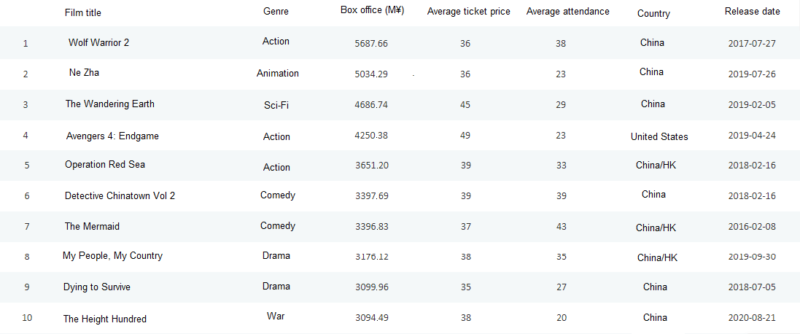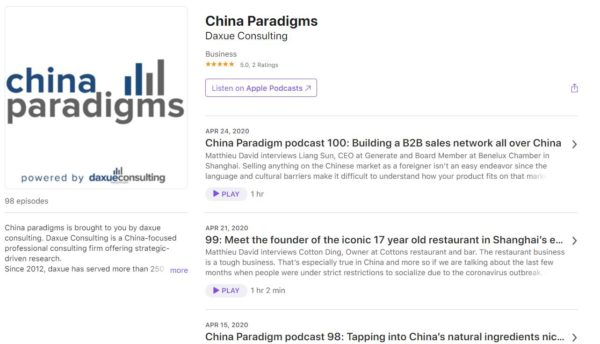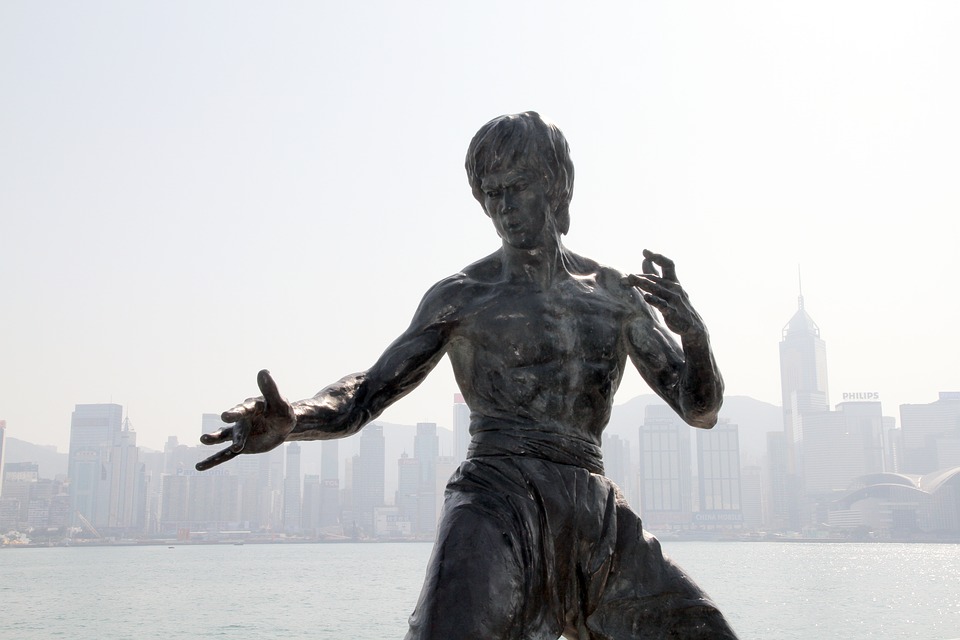If the Chinese movie industry did not immediately adopt the upward trend of other Chinese sectors which have been on since the late 80’s, when it finally did, it did so spectacularly. Starting from 2005, the Chinese movie industry revenue has soared, and new cinema screens took a more than tenfold increase. Today, movies in China represent a booming market grossing 61 billion Yuan (about 9.3 billion USD) in 2018. In terms of box office revenue, it is the second largest in the world behind the United States and the UNESCO Institute for statistics had predicted that it should become number one in the early 2020’s. Setting the foundation to become number one globally, in 2016, it already overtook the US in number of cinema screens.

Source: National Association of Theatre Owners, Chyxx.com. The number of cinema screens in China has surged in the last decade
The Chinese movie industry benefits from economic growth and cultural pride
Why are China’s entertainment and services industries booming?
The growth of the Chinese movie industry is largely carried by the explosion of the service sector profiting from a booming Chinese middle class. According to PwC, out of all industries from the service sector, the entertainment industry is growing the fastest, at a projected compound annual growth rate of 20% for the next 5 years, twice as fast as the world’s average.
At the forefront of this economic boom are the Chinese internet giants like Tencent and Alibaba. Like many services, going to the movies in China is often synonymous with making an online purchase. Online ticket sellers such as Maoyan and Wepiao have been selling millions of tickets per year as about half of movie tickets are bought online in China. A great testimony for the Chinese consumer’s interest in the movie industry: Douban, which is China’s equivalent to Amazon’s popular movie rating site IMBD, is the 16th most visited website in China.
Today’s Chinese audiences prefer to watch Chinese movies
A first look at the all-time highest grossing movies at the Chinese box office leaves us realizing that the vast majority are made in China. Going down the list, things start changing. In the top 100 highest grossing movies in China, 1 in 3 movies are US made blockbusters. These figures contrast with the box office of other East-Asian countries where Hollywood productions are more predominant. Chinese cultural confidence as well as fundamentally different social values from the US can explain why domestic productions tend to perform better compared to foreign movies in China.
Although, the region overall has had higher grossing domestic movies compared to western countries where Hollywood’s domination of the international industry is more noticeable. Statista shows that domestic productions have represented 55% to 65% of the Chinese box office shares. Over the years, cultural and administrative barriers coupled with a rapid growth of the local industry have helped Chinese movies secure large audiences. However, they rarely export themselves outside of China except for a few famed directors.

Source: Endata.com.cn. Out of the ten highest-grossing movies at the Chinese box office, only one was made in the West
What are the pros and cons of the Chinese government interventions in the Chinese movies industry?
A hot topic when talking about any Chinese media is censorship and Chinese cinema makes no exception. In 2015, a “joint pledge of self-discipline in Professional Ethics” was signed by fifty media and entertainment organizations in order to promote “healthy esthetics and socialist core values”.
Chinese censorship mainly focuses on content deemed too sexual, too violent, or “unpatriotic”, but because the system is heavily reliant on the self-censorship of filmmakers, sanctions are rarely applied. The harsh scrutiny on movies in China, especially big productions, has affected their artistic integrity to the point where Chinese movies rarely make an impact abroad outside of a few independent film makers such as Jia Zhangke and Xiaogang Gu. This lack of artistic freedom is also felt in the mainland where US productions are still popular despite the high barriers to entry.

Source: IMDB. Wolf Warrior 2, China’s greatest hit at the box office, has poor reviews outside the Mainland.
Foreign movies are subject to as much scrutiny as domestic productions. The censorship committee only allows 30 to 40 foreign movies in China per year. These movies may have scenes edited in compliance with the Chinese authorities’ requirements to be allowed in Chinese theatres. Hence, it is not uncommon that the running time of the Chinese cut of an US blockbuster is a few minutes shorter than the original. These measures against foreign films have worked as a sort of protectionism for the Chinese cinema industry and allowed domestic productions to thrive in the Mainland. Today, China is the second largest producer of feature films behind India’s Bollywood.
Hollywood is trying to conquer the Chinese box office
The Chinese movie industry’s large potential pushes movie studios to appeal to Chinese audiences
With an ever-expanding thriving market, it is no surprise that Hollywood wants a piece of the Chinese cinema pie despite the seemingly high barrier to entry on the Chinese movie market. Some major US blockbusters have already famously reported having grossed more in China than in North America. Among them: Fate of the Furious (390M$ in China vs 220M$ domestic), Transformers 5 (220M$ in China vs 130M$ domestic) and Warcraft (210M$ in China vs 40M$ domestic). Other western movies in China also tend to score high at the Chinese box office which is a great incentive for Hollywood studio executives to try to appeal to Chinese audiences, especially when the Chinese government offers to help to finance production.
And try they do: Transformers 3 was one of many American movies that featured a lot of Chinese brands product placement. In Transformers 4, not only the product placement returns but the entire last act of the movie takes place in China and the movie features Chinese actress Li BingBing in a supporting role.
Recently Disney released its live action adaptation of the Tale of Hua Mulan. Featuring an all-Asian cast and was filmed in China, the Movie was a clear attempt to cater to the Chinese audience but unlike Transformers 4, Disney’s Mulan was poorly received in China.

Left: Official Mulan Chinese poster. Right: Chinese promotional material for Transformers 4. Both examples of western productions trying to appeal to the Chinese audience.
Collaboration between Hollywood, China’s censors, and Chinese studios is stronger than ever
Although, most examples of Hollywood trying to please Chinese censors to have their movies put on the short list of authorized foreign movies in China are not so always extreme. Like their Chinese counterparts, Hollywood directors will practice self-censorship or consult the censorship committee on what is acceptable to show in a movie. These minor changes are almost always short scenes being cut or rewritten, like in the James Bond movie Skyfall where a scene of a security guard being killed was cut from the part of the movie taking place in Shanghai.
Collaboration between Chinese and American studios has also become more common, especially in China’s booming animation industry. As cooperative projects multiply, Kung fu Panda 3 was one of the first box office hits developed by Oriental Dreamworks, the Shanghai based branch of Dreamworks, which was, at the time, only used for additional production work. That studio was later renamed Pearl Studio and developed Abominable in 2019 distributed by Universal Pictures, and Over the Moon in 2020, distributed by Netflix. These are two animated movies made for foreign audiences featuring Chinese main protagonists that were well received overseas.
What do these trends tell us about the future of the Chinese movie industry?
- The Chinese movie industry is big and it is only going to get bigger, overtaking the US in the coming years as the highest grossing movie industry.
- Chinese consumers thirst for movies and Hollywood has made a habit for years now to try to appeal for that massive market. This trend is set to continue as western productions are still quite popular in China, partly due to the self-censorship of domestic productions.
- Although most Chinese productions are still vastly unknown in the West, as cooperative projects multiply, Chinese studios gain more and more experience working on projects intended for international audiences, with notably great success in the 3D animation movie industry. This growth coupled with a discreet yet solid independent scene make great prospects for the future of Chinese cinema.
Author: Camille Gaujacq
Learn something new? Stay updated on the Chinese market by following our WeChat, scan the QR code below, or subscribe to our newsletter

Listen to over 100 China entrepreneur stories on China Paradigms, the China business podcast
Listen to China Paradigm on Apple Podcast






